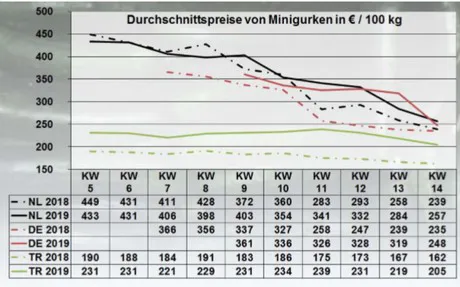Regarding regular cucumbers, goods from the Netherlands were much more dominant that those from Belgium and Germany. The presence of Spanish goods was limited. Greece supplemented. The availability expanded overall. The accommodation could have been faster at certain points. In Munich, larger calibers were scarce. Produce of a smaller diameter was selling well in Frankfurt, as they were sold somewhat cheaper. In general, prices were down; the traders were trying to speed up the trade, to reduce inventories. However, this was not always satisfactory. Mini cucumbers were mainly from the Netherlands and Germany. Turkish shipments rounded off the range of goods. Supply was in line with demand, so distributors seldom saw any reason to change their previous prices.

Apples
When looking at the constant sales, articles from around Europe usually left nothing to be desired in terms of quality. The traders often did not need to modify their prices. The influxes from overseas remained limited, but were certainly gaining in importance.
Pears
The presence of South African shipments intensified. However, the prices did not change significantly. Also, the prices of European fruits, such as the Italian Abate Fetel and the Dutch Conference, barely saw any modification.
Table grapes
In general, demand could be met without any effort. Stable prices were the result. From time to time, traders were even able to establish higher prices, provided that the sales kept on going smoothly.
Oranges
The season is on the home straight, although the quantities on offer were quite considerable. Due to the weakened interest, the building up of stocks could often not be avoided. This forced the distributors to correct their prices downwards.
Lemons
Spanish imports were mostly monopolizing the inventories. Demand had been noticeably reduced. Nevertheless, prices often remained at the level of the previous week.
Bananas
In general, the volume of ripeners' supplies was in line with the usually steady market outlets, even on the markets, where there was a somewhat tighter availability. This resulted in the majority of relatively constant valuations.
Cauliflower
The supply had been limited. Since demand could not always be met, the prices often shifted upwards.
Lettuce
In the ice berg lettuce and butterhead lettuce segments there was a friendly demand that could be satisfied without difficulty. At times, the sales went quite quickly. The prices remained stable for the most part, even tending a bit upwards from time to time.
Tomatoes
The availability of the Central European products intensified considerably. Moroccan and Spanish inflows were limited, which led to higher prices for tomatoes, in particular. Beef tomatoes were dropping in price due to the abundantly available quantities.
Sweet peppers
Spanish fruits in part had some quality problems, which made the Dutch batches sell for more. Sometimes the red cultivars became somewhat cheaper. The high-priced Turkish imports did not always meet the desired demand.
Asparagus
The presence of local offerings intensified. The demand could not keep up. This led to the lowering of prices here and there. The prices dropped off locally until Friday. In some places, they only went down until Thursday and then they tended to go upward again.
